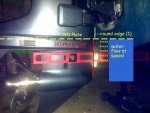100333624
Petty Officer 1st Class
- Joined
- Apr 24, 2012
- Messages
- 205
OK, it's a 2 stroke 115 HP Yam.
Need some information about last pic posted data :
- At which trim position were you when water flow passed right under upper plate, trimmed down, middle, trimmed up ?
- Was load well distributed on deck to achieve a well balance combo.
- How much under upper plate was water flow at speed passing bye ?
- How did you check the posted height while water flow was passing through lower leg.
- Popped you head out transom, installed a go pro cam on transom facing downwards, someone was having g a look from other boat ?
Happy Boating
My trim gauge doesn't read properly, I trim it by feel. I am not sure exactly at what moment I looked over at it but I know I was trimmed out quite a bit at max throttle, told my partner to hold the wheel while I quickly stepped back to check. I can easily check it on my boat as long as I got someone to take the wheel. Load is distributed pretty good throughout the boat. I believe the upper plate was about an inch above the water surface and it was in the splash. It was pretty much where I would normally see the anti vent plate on others boats who've raised motors at the "optimum" height, which is just at or just above the water surface in the splash. I hope that answers your questions?
I will do a thorough test run tomorrow and will take some pictures possibly video too and post them for clarification.




















